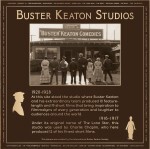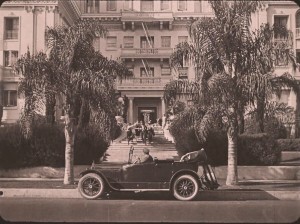Charlie Chaplin’s One A.M. Mystery SOLVED!!
Charlie Chaplin’s 1916 film One A.M. begins with him portraying a wealthy drunk struggling to exit a taxicab. Filmed on location, this setting has been a mystery for over a century, until Sarah Lagrillière, a brilliant film preservationist and avid visual historian from Finland (!), solved the puzzle. Incredibly, the scene was staged along Hollywood Blvd, almost due north from where Chaplin would later build his studio across a lemon grove less than 2 years later.
Click to enlarge – first, this composite photo looks south along Hollywood Blvd west of Sycamore. One movie frame shows where Charlie exits the taxi, the other movie frame matches perfectly with the back of the homes facing south along Hawthorne Ave, while the arrow leads from the filming site to the future Chaplin studio site at 1416 N La Brea. USC Digital Library. The home with the rooftop gable appearing beside the two images of Albert Austin at top was 7071 Hawthorne.
 Chaplin filmed One A.M. at the Lone Star Studio, located at Eleanor and Lillian Way. Buster Keaton began his independent productions filming at the same small studio in 1920. The studio site where Chaplin AND Keaton both filmed has been honored with a commemorative plaque installed by the Damfinos, The International Buster Keaton Society.
Chaplin filmed One A.M. at the Lone Star Studio, located at Eleanor and Lillian Way. Buster Keaton began his independent productions filming at the same small studio in 1920. The studio site where Chaplin AND Keaton both filmed has been honored with a commemorative plaque installed by the Damfinos, The International Buster Keaton Society.
 Look closely and you’ll notice a trolley passes Charlie as he struggles exiting the taxi. The Lone Star Studio stood a short block south of the Santa Monica Blvd trolley line, and at the time the area was sparsely developed. It would have been efficient to film the scene on Santa Monica near the studio, but they didn’t. Analyzing vintage photos and historic maps show the details just don’t match.
Look closely and you’ll notice a trolley passes Charlie as he struggles exiting the taxi. The Lone Star Studio stood a short block south of the Santa Monica Blvd trolley line, and at the time the area was sparsely developed. It would have been efficient to film the scene on Santa Monica near the studio, but they didn’t. Analyzing vintage photos and historic maps show the details just don’t match.
The first big break came when Michael Aus released his wonderful Lyons and Moran DVD of early Universal comedy films. One featured short Waiting at the Church (1919) starring Eddie Lyons and Lee Moran (see post Time Travel to 1919 Hollywood HERE) is one of the most visually consequential silent films I’ve ever seen, with scenes filmed all around early La Brea, Highland, and nascent Hollywood Boulevard.

Click to enlarge – One A.M. at left, note trolley tracks, matching homes from Waiting at the Church at right.
As reported three years ago in a post pleading for help solving this One A.M. mystery, background details confirm Charlie, and Lyons and Moran filmed scenes at the same location. The location block pattern was clear – a vacant front lot along a trolley line, then an alley, then a back lot lined with small garages facing the alley and taller homes facing the adjacent street.

Matching details with One A.M. top and Waiting at the Church below
Further, given the angle of the light, I “assumed” the view looked east (HUGE MISTAKE). After scrutinizing vintage maps and aerial photos for candidate blocks east of trolley lines, one block along Highland Ave jumped out. The pieces all seemed to fit, no other block fit as well, and as further “proof” Lyons and Moran had filmed other scenes on McCadden Place just a block away. This had to be the correct site, but the aerial photos were too distant to say for certain.


But Waiting at the Church provided another big clue. Wider views of our location revealed a curved irrigation ditch running below the street with the trolley line, guarded by a metal safety railing (above) to protect people from falling into the ditch. Charlie must have exited his taxi near this railing. All we needed to prove this Highland block was correct was to track down some early adjacent drainage or irrigation channel.
 Three years ago I pleaded for help, and Al Donnelly came aboard. A Hollywood area native, now retired in Oregon, Al is an expert historian, focusing on railroads and infrastructure. Al sent numerous vintage maps, construction plans, diagrams, and early photos that we dissected trying to find some tangible clue placing a canal or ditch adjacent to Highland. One remarkable document, Al shared this 1888 irrigation map showing Colegrove, and where Hollywood would later be developed, covered with a grid of canals and ditches. But again, these records were just too broad to confirm a single ditch at a single spot. David Rumsey Historical Map Collection.
Three years ago I pleaded for help, and Al Donnelly came aboard. A Hollywood area native, now retired in Oregon, Al is an expert historian, focusing on railroads and infrastructure. Al sent numerous vintage maps, construction plans, diagrams, and early photos that we dissected trying to find some tangible clue placing a canal or ditch adjacent to Highland. One remarkable document, Al shared this 1888 irrigation map showing Colegrove, and where Hollywood would later be developed, covered with a grid of canals and ditches. But again, these records were just too broad to confirm a single ditch at a single spot. David Rumsey Historical Map Collection.
 Then, out of the blue three years later, Sarah Lagrillière emailed the answer from Finland, the Chaplin One A.M. mystery was finally solved! Sarah is brilliant, and did several brilliant things. First, she didn’t fall for my assumption the view looked east (it looks south). She allowed herself to consider all possibilities. Next, she didn’t focus on some canal or ditch, she focused on the distinctive homes appearing at back. Studying vintage photos, some presented in my post about early Hollywood, before the Chaplin Studio was built, the corner of Hollywood and Sycamore stood out to her. Plain as day, she saw what I had overlooked. I am so happy she shared this with us.
Then, out of the blue three years later, Sarah Lagrillière emailed the answer from Finland, the Chaplin One A.M. mystery was finally solved! Sarah is brilliant, and did several brilliant things. First, she didn’t fall for my assumption the view looked east (it looks south). She allowed herself to consider all possibilities. Next, she didn’t focus on some canal or ditch, she focused on the distinctive homes appearing at back. Studying vintage photos, some presented in my post about early Hollywood, before the Chaplin Studio was built, the corner of Hollywood and Sycamore stood out to her. Plain as day, she saw what I had overlooked. I am so happy she shared this with us.
 Charlie’s choice of location is puzzling. The mundane background does not suggest the urban nightclub life, and why would he travel two miles for such a generic shot on Hollywood Blvd when a comparable bland background was available right at his Mutual studio? Further, the spot was just steps to the west from the fabulous (now lost) Garden Court luxury apartments. One A.M. was released August 7, 1916, and a Hollywood historian reports the Garden Court was built in 1916. At left, the Garden Court appears in the 1922 promotional film Night Life in Hollywood hosted on YouTube by Joseph Blough.
Charlie’s choice of location is puzzling. The mundane background does not suggest the urban nightclub life, and why would he travel two miles for such a generic shot on Hollywood Blvd when a comparable bland background was available right at his Mutual studio? Further, the spot was just steps to the west from the fabulous (now lost) Garden Court luxury apartments. One A.M. was released August 7, 1916, and a Hollywood historian reports the Garden Court was built in 1916. At left, the Garden Court appears in the 1922 promotional film Night Life in Hollywood hosted on YouTube by Joseph Blough.
It seems unlikely, but if, if, the completed building and the movie filming overlapped, perhaps Charlie originally filmed at the Garden Court. Charlie portrays a wealthy drunk, so what if they decided to film at one of the few fancy buildings in town? Again, this is speculation, not likely, but imagine Charlie then realized this lavish building in the background would distract from him getting out of the cab, so he simply moved just down the street instead. What do you think? Does some theory explain why Charlie filmed this scene two miles from his studio?
 Click to enlarge – more context, Sarah suggests the arrow seems to point toward the same tree in both this 1919 Watson Family Archive aerial photo and in this 1919 Waiting at the Church frame. Notice the large white Garden Court Apartments near the center. Note: the tip of the triangular traffic island in the aerial photo is where Buster Keaton built his private safe doorway set in Sherlock Jr. (1924).
Click to enlarge – more context, Sarah suggests the arrow seems to point toward the same tree in both this 1919 Watson Family Archive aerial photo and in this 1919 Waiting at the Church frame. Notice the large white Garden Court Apartments near the center. Note: the tip of the triangular traffic island in the aerial photo is where Buster Keaton built his private safe doorway set in Sherlock Jr. (1924).
 Click to enlarge – this 1918 Charlie Chaplin Archive photo looking north shows the Chaplin Studio lower right, with the above-ground backlot “trench” set built for Shoulder Arms. I decided not to annotate this photo, but hopefully you can clearly see the Garden Court, Sycamore, Hawthorne, and the One A.M. vacant lot filming site near the top.
Click to enlarge – this 1918 Charlie Chaplin Archive photo looking north shows the Chaplin Studio lower right, with the above-ground backlot “trench” set built for Shoulder Arms. I decided not to annotate this photo, but hopefully you can clearly see the Garden Court, Sycamore, Hawthorne, and the One A.M. vacant lot filming site near the top.
Click to enlarge – for comparison, this circa 1906 photo looking south shows Sycamore, with a few homes on Hawthorne facing the camera. USC Digital Library.
Thanks again to Sarah Lagrillière, Al Donnelly, Michael Aus, and the others who offered suggestions over the years, for uncovering a tantalizing glimpse of early Hollywood history.
 Then and now – 7060 Hollywood Blvd west of Sycamore
Then and now – 7060 Hollywood Blvd west of Sycamore
Charlie’s studio on La Brea was once a lemon grove. This YouTube video shows more of Charlie’s studio neighborhood.






